Note: This article was the MASS Research Review cover story for April 2023 and is a review of a recent paper by Vargas-Molina et al. If you want more content like this, subscribe to MASS.
Key Points
- 14 resistance-trained women were randomized into two groups: a severe energy deficit group (25kcal/kg of fat-free mass per day) or a progressive energy deficit group (40kcal/kg of fat-free mass per day, decreasing by 5kcal/kg every two weeks) for eight weeks.
- After eight weeks of dieting combined with resistance and cardiovascular training, there were no significant differences between groups for changes in body composition or performance.
- Notably, the severe energy deficit group was prescribed a greater net energy deficit for the eight weeks observed; however, they did not lose more fat or body mass. Thus, likely due to poorer adherence, the intended greater net energy deficit did not occur.
We all want to reach our goals yesterday, which is why the allure of crash dieting will never go away, and why studies like the presently reviewed one (1) are important. On paper, there is a lot of appeal to faster weight loss. You spend less time altering your lifestyle and being uncomfortable, and you make fast, visible progress which can be very motivating. Unfortunately, what works on paper doesn’t always work in the real world. As discussed by Dr. Trexler in his review of a meta-analysis comparing slow versus faster rates of weight loss (2), when comparing interventions that result in similar total weight loss, faster rates lead to a slightly higher proportion of weight lost as lean mass, a slightly lower proportion as fat mass, and slightly greater metabolic adaptation. Thus, it seems the fable “the tortoise versus the hare” applies in the context of dieting. However, savvy readers might say “that’s only when matching for similar weight loss – the whole purpose of choosing a faster rate of loss is to lose more total weight in the same time frame.” That’s absolutely true; however, the present study suggests that attempts at rapid weight loss don’t always result in more total weight loss than slower diets, even when applied over the same time period. In the present review, we’ll dive into these findings and discuss what happened (and why).
Purpose and Hypotheses
Purpose
The authors stated that “the aim of this study was to compare the effects of an 8-week high-protein SER [severe energy deficit] or PER [progressive energy deficit] dietary intervention accompanied by a high-volume concurrent training (CT) program on body composition and strength-related variables in resistance-trained women.”
Hypothesis
The authors hypothesized “that eight weeks of a [progressive energy deficit] intervention would elicit a greater reduction in FM [fat mass] while maintaining FFM [fat-free mass] and strength levels compared to a [severe energy deficit] due to a better adherence to the nutritional strategy in resistance-trained women.”
Subjects and Methods
Subjects
14 women (29.5 ± 3.8 years old; 164.9 ± 7.0 cm tall; 63.1 ± 9.0 kg body mass; 23.8 ± 2.8 BMI) with at least two years of training experience and no reported performance enhancing drug use in the last two years participated in this study. Participants had to be between the ages of 18-35, regularly menstruating, and were not permitted to perform any exercise outside of the study or use any ergogenic supplements during the study.
Study Design
This randomized, parallel-group trial compared body composition and performance changes over eight weeks in women performing concurrent aerobic and resistance training split between two groups: a severe energy deficit group (n = 7) and a progressive energy deficit group (n = 7). All participants in this study were recruited following the completion of a prior eight-week study by the same lab group where they were prescribed a 45kcal/kg of fat-free mass per day ketogenic diet while performing resistance training for the purpose of increasing muscle mass (3; reviewed here). Prescribed training was identical in both groups in the present study, with the only variable that differed being the severity and pattern of energy restriction.
Diet Specifics
In the severe group, the participants were prescribed a 25kcal/kg of fat-free mass per day diet and were instructed to follow it for the full eight weeks. However, the progressive group started at 40kcal/kg of fat-free mass per day and reduced this intake every two weeks by 5kcal/kg per day. Thus, they consumed 40kcal/kg of fat-free mass per day in weeks one and two, 35kcal/kg in weeks three and four, 30kcal/kg in weeks five and six, and 25kcal/kg per day in weeks seven and eight. Individuals in both groups were assigned macronutrient distributions of 2g/kg of protein, 1g/kg of fat, and the remaining calories from carbohydrates. All participants recorded digital food logs using the MyFitnessPal app and received guidance from “a sports nutritionist with experience in RT [resistance training]” who helped them manage their diets. (I’d add that they also had been doing so for the previous eight weeks since they were recruited out of a prior study.)
Training Specifics
Participants trained six days per week, following a four day per week upper/lower resistance training split (two upper-body sessions and two lower-body sessions per week), and performed a total of six aerobic training sessions. Resistance training sessions followed a format where the participants completed heavy multi-joint exercises paired with light single-joint exercises (super sets). Immediately following the resistance training session, the participants performed 20 minutes of cycling at 65% of heart rate reserve, and on two non-lifting days, they performed 45 minute aerobic sessions at the same intensity. They had one “rest day” per week on which they abstained from both aerobic and resistance training. Specific details of the training plan are displayed in Figure 1.
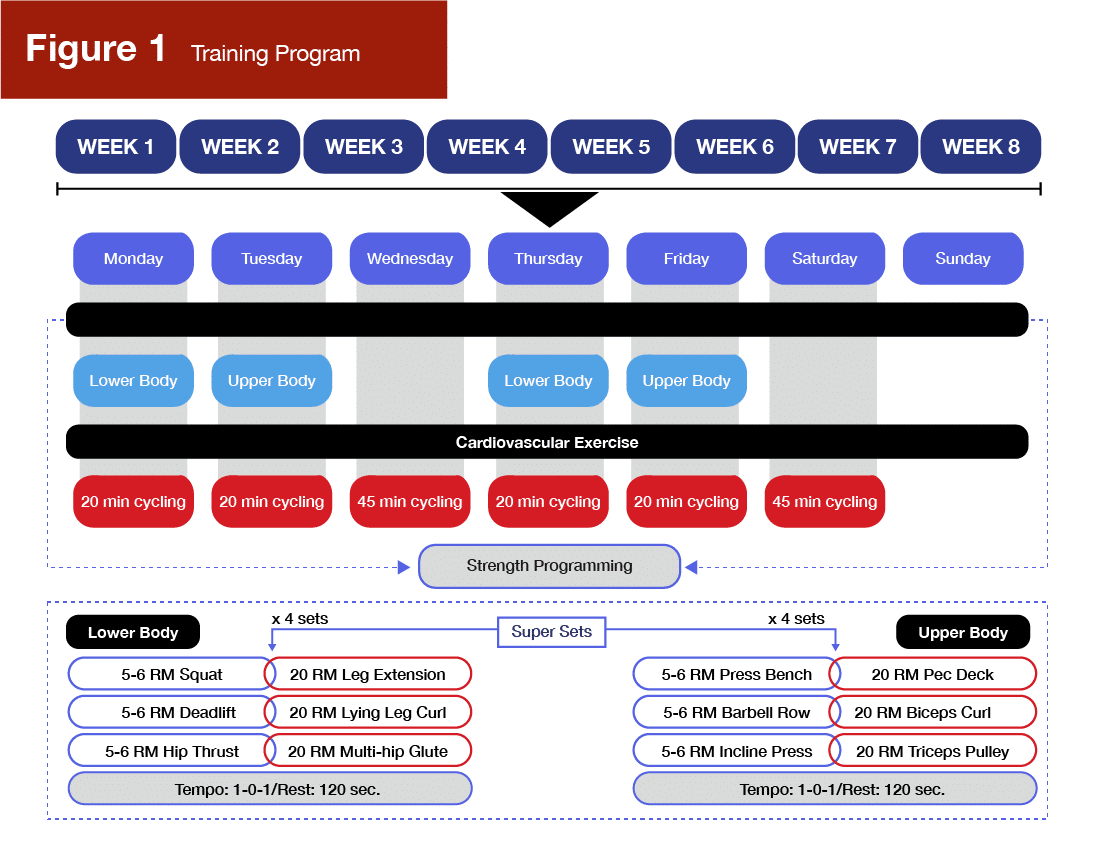
Testing Specifics
Pre- and post-intervention body composition was measured by DXA seven days after menstruation to prevent hormone-mediated water retention from confounding the results. Notably, the authors reported not only lean mass changes but also lean mass changes corrected for “fat-free adipose tissue.” Since only ~85% of adipose tissue is actually fat mass, this means the remaining ~15% of adipose tissue is technically fat-free mass (4). Thus, they reported both lean mass changes and lean mass changes minus this fat-free adipose tissue value. To assess changes in performance, participants’ countermovement jump height and Smith machine squat and bench press 1RMs were assessed following 48 hours of exercise abstention at both pre- and post-testing.
Findings
Nutrition
Macronutrient and energy intakes were estimated from food records, as shown in Table 1. While energy intake was lower in the severe deficit group in weeks one and two (p = 0.01), there were no significant energy intake differences in weeks three to six (p = 0.12-0.17). Despite intentions, the severe intake group had a significantly higher energy intake than the progressive deficit group in weeks seven and eight (p = 0.003).
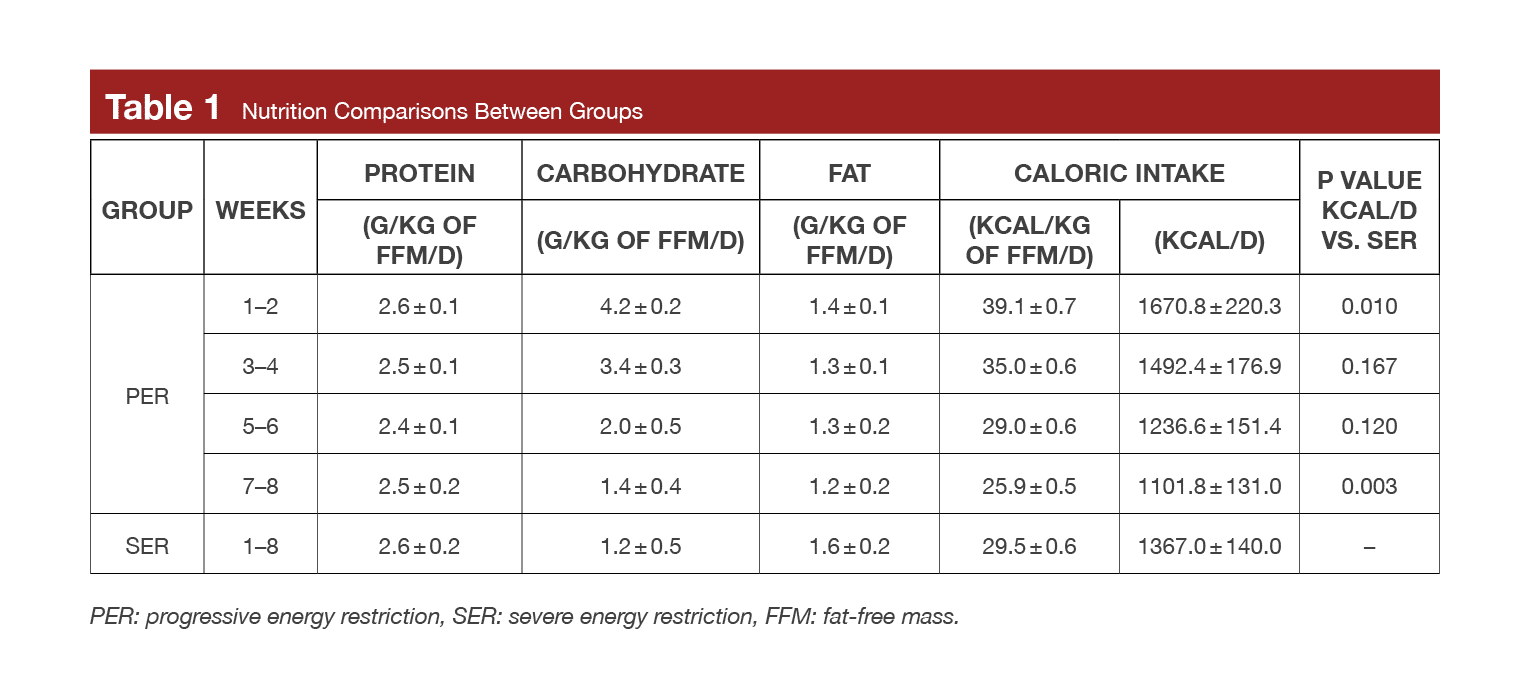
Body Composition
There were no significant body composition group differences (p = 0.11-0.52). Versus baseline, both groups lost significant body and fat mass, but only the progressive deficit group lost a significant amount of fat-free mass (-0.6 ± 0.4 kg; p = 0.008). Fat-free mass reductions in the severe group were similar in magnitude, but were not statistically significant (-0.4 ± 0.8 kg; p = 0.258). When corrected for fat-free adipose tissue, neither group’s change was significant (p = 0.07-0.58). Even without this correction, however, there were no between group differences, mean changes in fat-free (-0.6 ± 0.4 vs -0.4 ± 0.8) and corrected fat-free mass (-0.3 ± 0.1 vs -0.2 ± 0.1) were similar (and small), and in Figure 2, you’ll see one subject gained over a kilogram of fat-free mass in the severe group. This likely caused this group to not have a significant drop in fat-free mass. Thus, ultimately, there were no statistically discernible or meaningful body composition differences between groups.
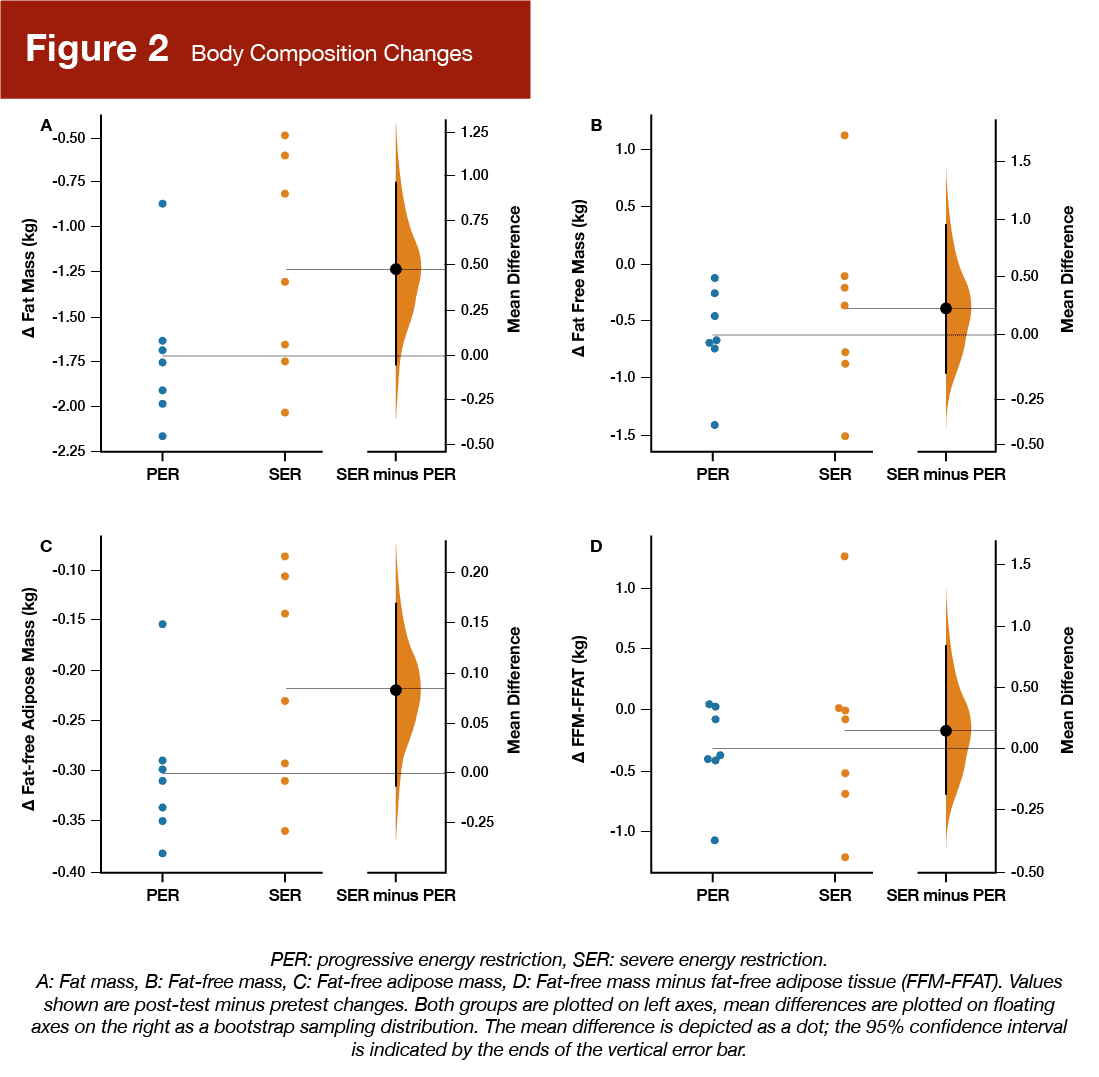
Performance
As shown in Figure 3, there were no significant changes within either group compared to their baseline performance values (p = 0.10-0.94), nor were there any significant differences between groups over time (p = 0.39-0.97).
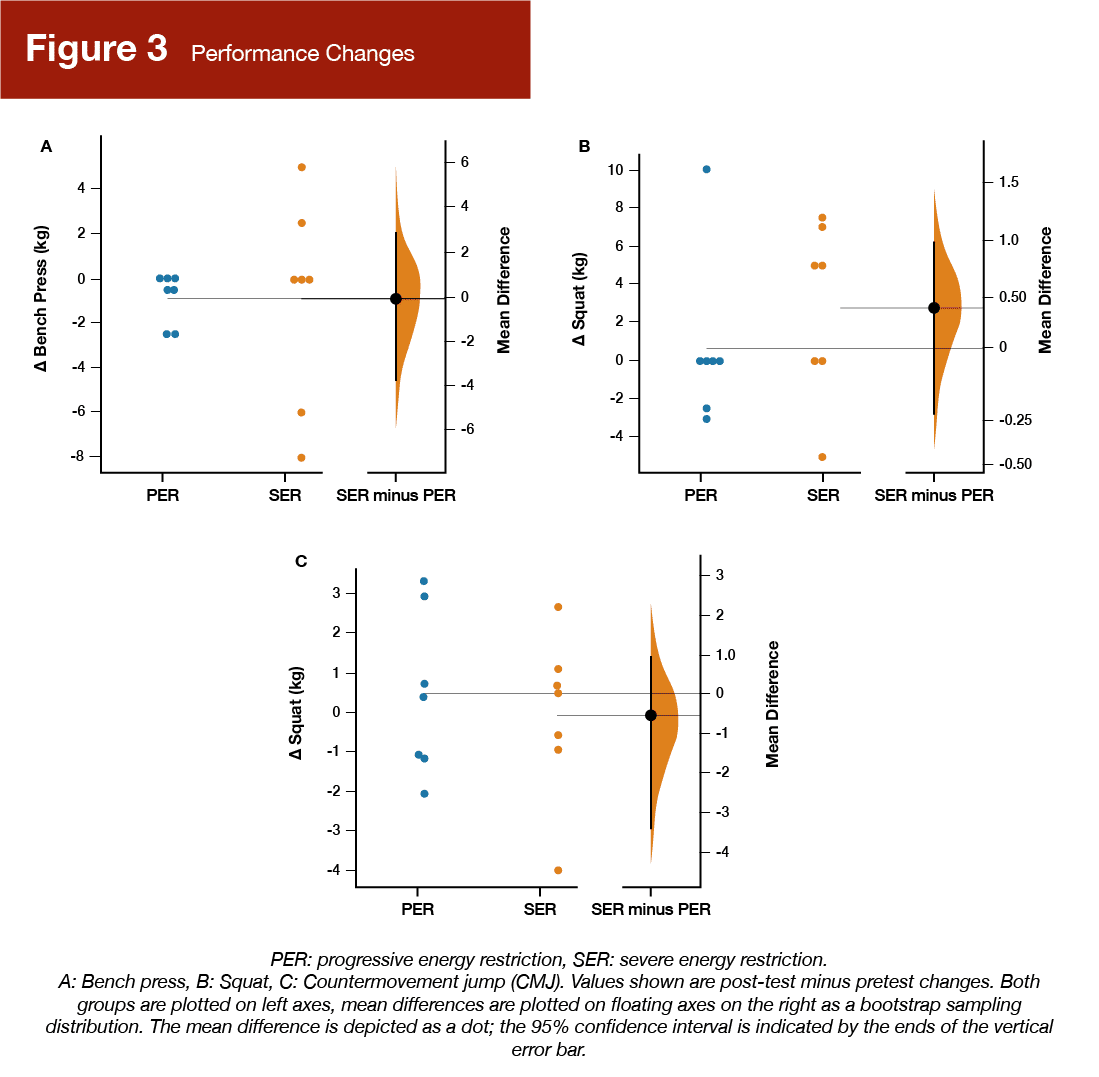
Interpretation
If these participants were robots, you’d have expected greater total body mass losses as well as fat mass losses in the severe energy deficit group. While the progressive deficit group eventually got to the same relative energy intake of 25kcal/kg of fat-free mass per day as the severe deficit group, for the first six weeks of this eight-week study the progressive deficit group was prescribed a higher relative energy intake (30-40kcal/kg of fat-free mass). Thus, on paper, the net energy deficit should have been higher in the severe deficit group, and subsequently, they should have lost more body mass and fat mass. But, that’s not what happened. If that had happened, this interpretation would have a different focus. Instead of writing about the impact of larger or smaller deficits on adherence, which I will discuss, I’d focus on their impacts on body composition. In the interest of completeness and to be charitable to faster weight loss, let’s take a diversion and discuss another study with a subtly different design before I dive into the present findings.
Garthe and colleagues published a study in 2011 where they prescribed a group of mixed-sex elite athletes diets intended to cause “slow” weekly body mass losses of 0.7% or “fast” losses of 1.4% (5). While dieting, the athletes performed a four-day upper/lower resistance training split in addition to their sports training, quite similar to the present study. However, the authors prescribed the diets based on weight loss targets, rather than relative energy intake. Specifically, they made an ecologically valid design decision to prescribe individualized diet lengths based on the personal goal weight and group assignment (0.7% or 1.4% target weekly weight loss) of each participant. For example, a 70kg athlete who wanted to lose 5kg would have been prescribed a five-week diet if they’d been assigned to the fast loss group, but a 10-week diet if they’d been assigned to the slow loss group. Thus, there was a mean diet length of 8.5 ± 2.2 and 5.3 ± 0.9 weeks in the slow and fast loss groups, respectively.
Perhaps unsurprisingly, given this was a group of elite athletes, adherence was quite high as indicated by the same mean body mass losses (-4.2 ± 0.6 kg) in both groups (which was again, accomplished faster by the fast loss group). However, as shown in Figure 4, the proportions of the body composition changes differed between groups such that there were significant differences in lean and fat mass changes favoring the slow loss group. The slow loss group actually gained a small amount of lean mass on average, while the fast loss group lost a small amount of lean mass on average, and thus, subsequently lost a smaller proportion of their weight as fat mass.
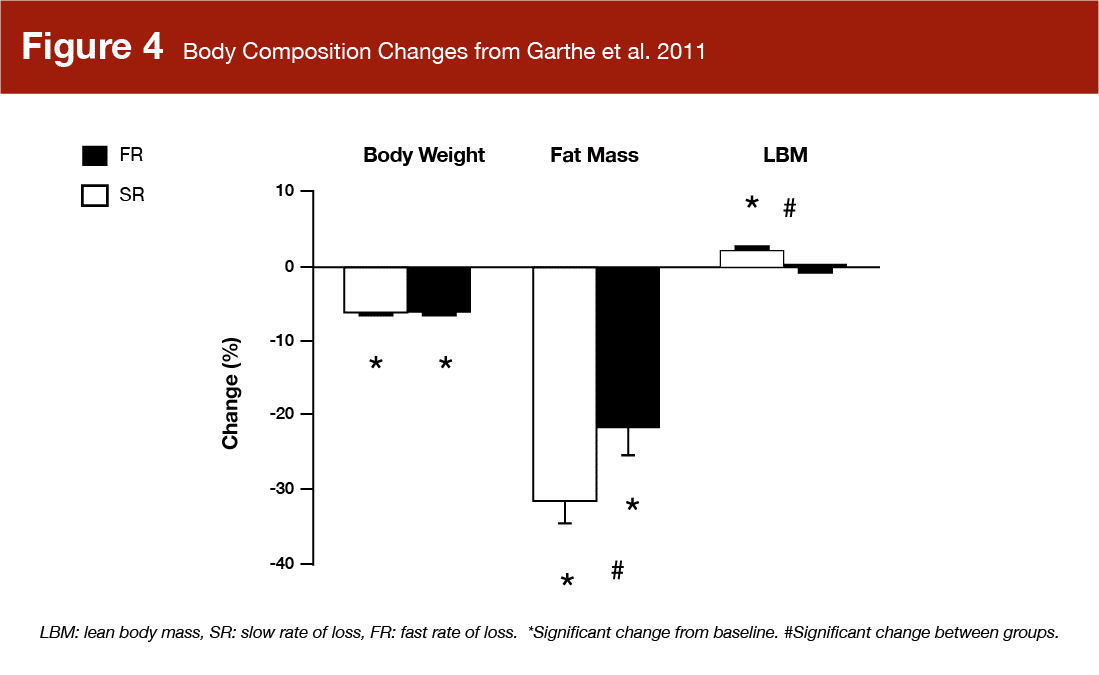
The findings of Garthe and colleagues illustrate that at best, faster weight loss is a trade-off where you reach your goal slightly faster, but the results are slightly poorer. Like the present study, a progressive, challenging resistance training protocol was followed and sufficient protein was consumed (~1.6g/kg in the study by Garthe), yet results still favored the slower loss group. This shows how the size of the energy deficit is one of the most important variables dictating diet success. To be fair, however, you might view the results differently if you primarily value getting to your goal faster, as the loss in lean body mass was not much in the fast loss group (-0.3 ± 0.4 kg). Thus, this trade-off may potentially be worth it to some people in some instances (as a side note, however, this whole discussion gets more complicated if the goal is to maintain weight loss long term, rather than simply reaching a target weight for competition).
If we take the findings of Garthe and tie them into the present study, we get another layer of nuance. Specifically, we realize that the entire concept of faster weight loss being a potentially worthwhile trade-off only makes sense if it actually works. The present study didn’t use variable, individualized diet lengths for each participant. Instead, everyone had to diet for eight weeks. That means the severe energy deficit group had to tough out a larger deficit for much longer, while the progressive energy deficit group was only prescribed a similarly challenging deficit for the final two weeks, after six weeks of easier dieting with the proverbial “light at the end of the tunnel” quite close. This probably influenced the adherence to the diet, as the severe deficit group only recorded a significantly lower energy intake compared to the progressive deficit group for the first two weeks of the diet. Then, adherence likely started to wane, and the energy intakes of the two groups were not significantly different in weeks three to six, and in fact, the progressive deficit group (despite being prescribed the same relative energy intake) consumed significantly lower calories than the severe deficit group in the final two weeks. This finding aligns with something we’ve anecdotally observed for years at 3D Muscle Journey. As described by my colleague Coach Alberto Nuńez, there is an inverse relationship between the prescribed energy deficit and diet adherence, such that the intention to diet harder results in more adherence issues, and – as shown in the present study – can actually land you in the same place you’d have gotten to with a less aggressive diet, but with more frustration and self-loathing. Whether it was the fact that the fast loss participants in the study by Garthe had shorter diets or because they were elite athletes (or likely both), they had better adherence to a larger deficit than the participants in the severe deficit group in the present study.
Therefore, it might be ok to use larger deficits to pursue faster weight loss when you do it for a shorter period of time. Thus, if you have a lot of weight to lose, and therefore a longer-term goal, larger deficits probably aren’t a good idea, at least for the entirety of the diet. Although, you could potentially implement large deficits initially, subsequently decreasing the size of the deficit (or taking a diet break) when things get challenging. What do I mean by “large?” Well, I probably wouldn’t go higher than a rate of loss in the range of 1.5-2% of body mass per week. Further, the upper end of this rate can be too high in cases of people who weigh in excess of ~200lbs, as it requires very large deficits (2000kcals/day+), so a functional lower limit of 25kcal/kg of fat-free mass – as used in the present study – is probably a decent guideline. But even then, based on prior research, it’s worth the reminder that for the same total weight loss, you might get slightly poorer results in terms of the composition of that weight loss, even when you have the other big rocks in place (progressive resistance training and sufficient protein intake).
Next Steps
This study had a progressive energy deficit group that steadily decreased its intake. But, what about a deficit group that steadily increased its intake? I would like to see a study where two different forms of progressive energy restriction matched for the same prescribed net deficit are compared. Specifically, one group would follow a diet like the progressive group in the present study (although I’d prescribe energy as a percentage reduction from maintenance calories rather than kcal/kg to avoid the impact of individual differences in energy expenditure), and the second group would follow the opposite pattern. Specifically, their energy intake would start low and then get higher over time, such that they’d have the smallest prescribed deficit at the end of the study. Theoretically, I’d hypothesize that when body fat stores are higher and diet fatigue is lower at the start of the diet, the participants would have better adherence to a large deficit. Then, as diet fatigue increased and they lost progressively more body fat, a smaller deficit might improve adherence and reduce losses in lean mass. Lastly, it would be ideal if energy expenditure was measured in this proposed study to determine if metabolic adaptations differed between groups (which notably weren’t measured in the present study).
Application and Takeaways
Fast weight loss, or at least the intention to lose weight faster, can backfire. As shown in the present study, trying to follow a larger deficit doesn’t necessarily mean you’ll be able to. You might get to the same place you would have with a less aggressive approach, but with more frustration. Even when you can stick to a more aggressive deficit, the quality of your body composition changes might be poorer than if you’d lost the same amount of weight over a longer time period. While there are times this trade-off might be worthwhile, a weight-loss rate of 0.5-1% of body mass per week is generally a better choice to improve adherence and body composition outcomes.
Get more articles like this
This article was the cover story for the April 2023 issue of MASS Research Review. If you’d like to read the full, 100-page April issue (and dive into the MASS archives), you can subscribe to MASS here.
Subscribers get a new edition of MASS each month. Each edition is available on our member website as well as in a beautiful, magazine-style PDF and contains at least 5 full-length articles (like this one), 2 videos, and 8 Research Brief articles.
Subscribing is also a great way to support the work we do here on Stronger By Science.
References
- Vargas-Molina S, Bonilla DA, Petro JL, Carbone L, García-Sillero M, Jurado-Castro JM, et al. Efficacy of progressive versus severe energy restriction on body composition and strength in concurrent trained women. Eur J Appl Physiol. 2023 Feb 17, Epub ahead of print.
- Ashtary-Larky D, Bagheri R, Abbasnezhad A, Tinsley GM, Alipour M, Wong A. Effects of gradual weight loss v. rapid weight loss on body composition and RMR: a systematic review and meta-analysis. Br J Nutr. 2020 Dec 14;124(11):1121-1132.
- Vargas-Molina S, Petro JL, Romance R, Kreider RB, Schoenfeld BJ, Bonilla DA, et al. Effects of a ketogenic diet on body composition and strength in trained women. J Int Soc Sports Nutr. 2020 Apr 10;17(1):19.
- Heymsfield SB, Gallagher D, Kotler DP, Wang Z, Allison DB, Heshka S. Body-size dependence of resting energy expenditure can be attributed to nonenergetic homogeneity of fat-free mass. Am J Physiol Endocrinol Metab. 2002 Jan;282(1):E132-8.
- Garthe I, Raastad T, Refsnes PE, Koivisto A, Sundgot-Borgen J. Effect of two different weight-loss rates on body composition and strength and power-related performance in elite athletes. Int J Sport Nutr Exerc Metab. 2011 Apr;21(2):97-104.




